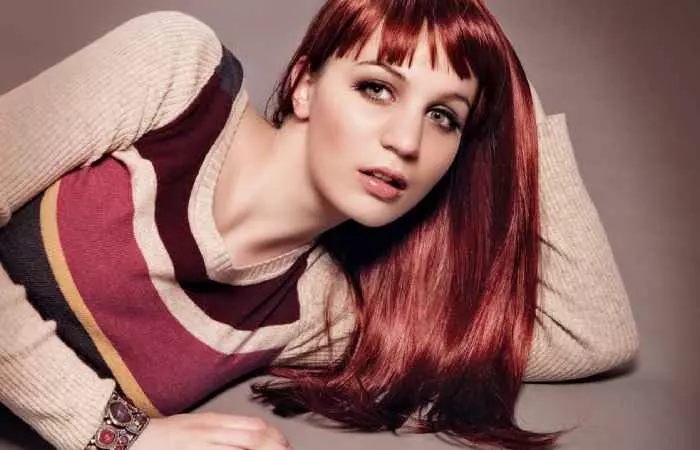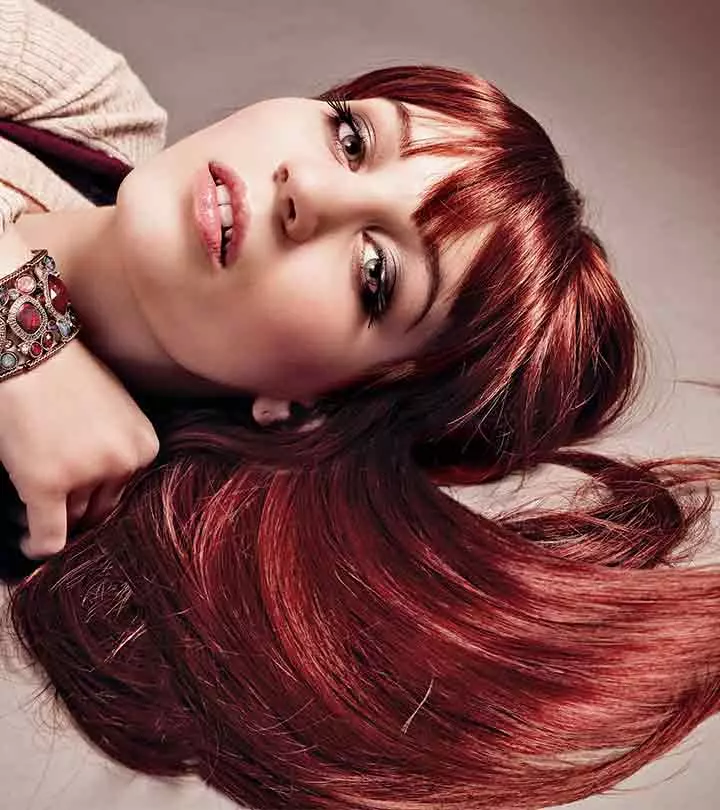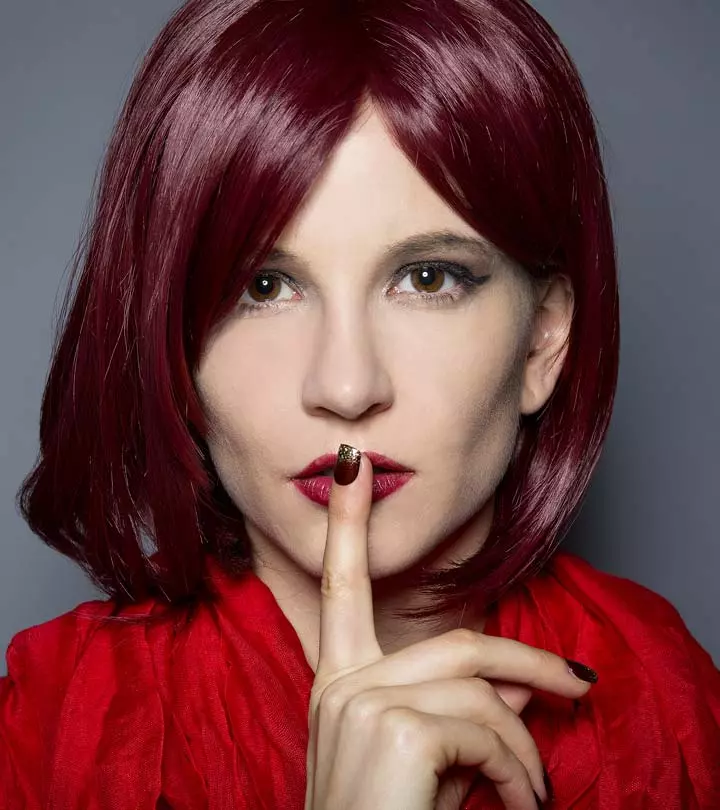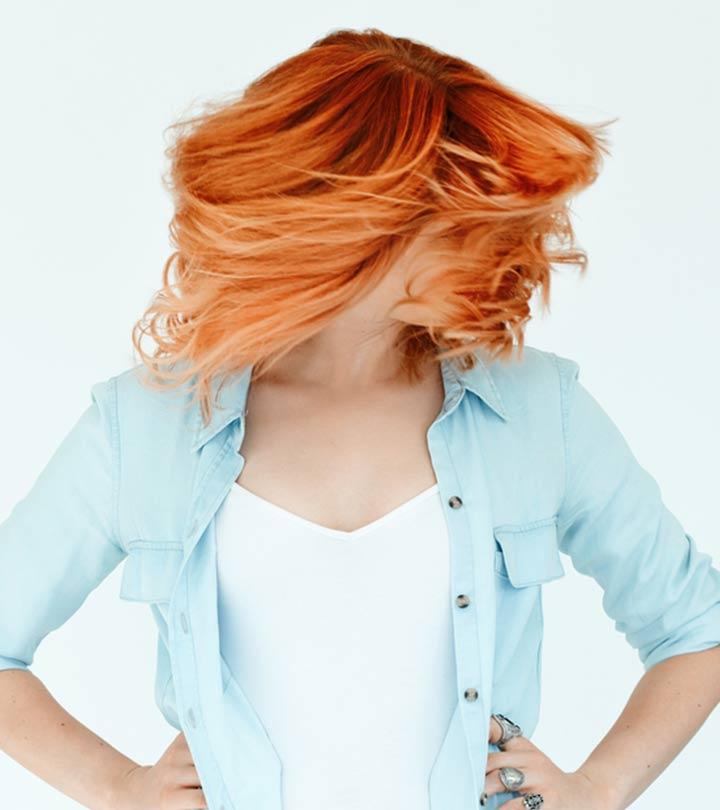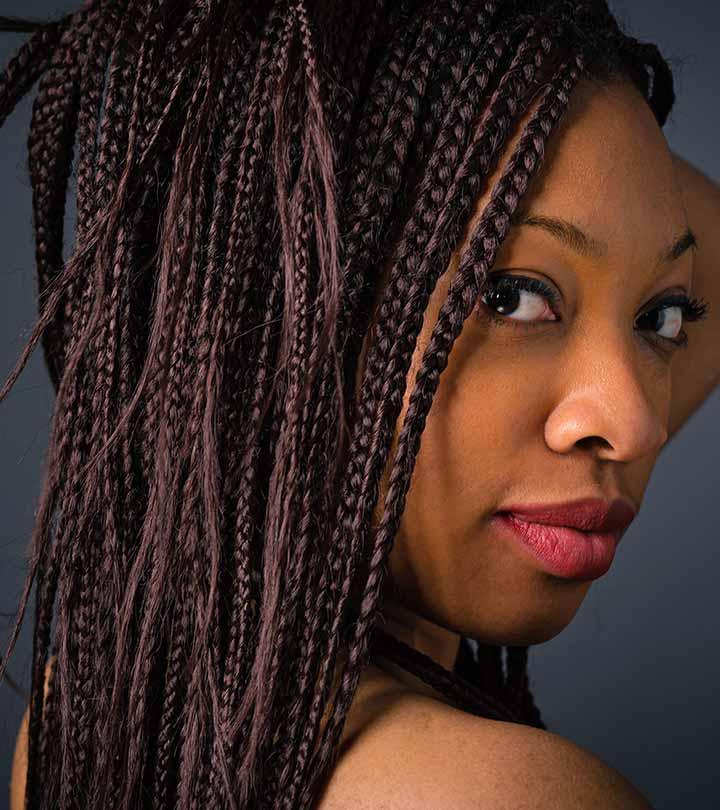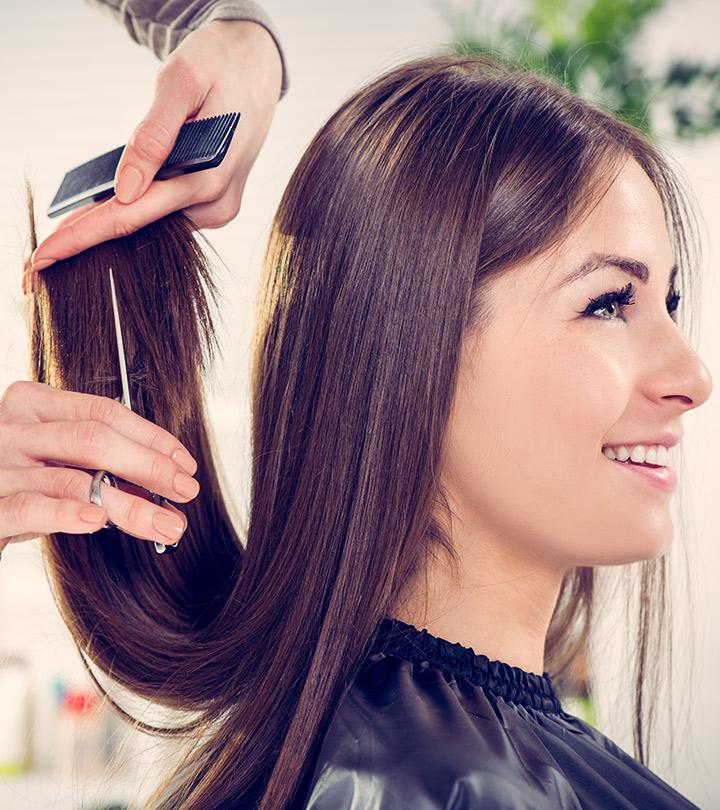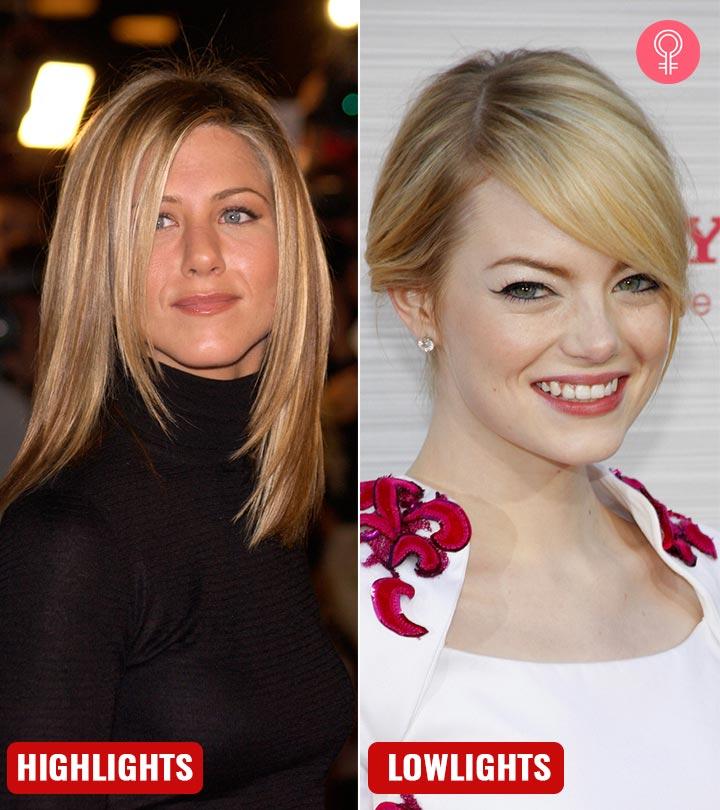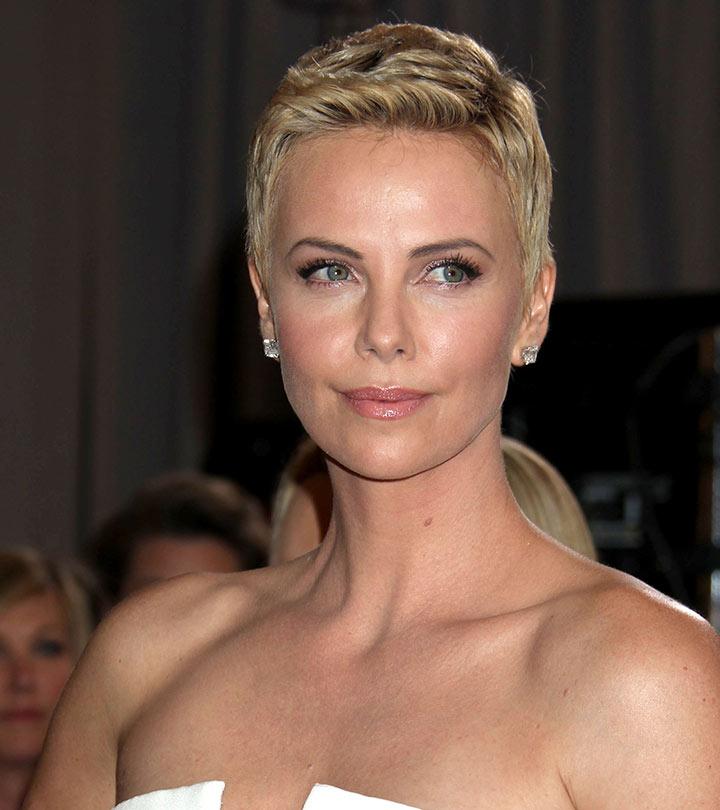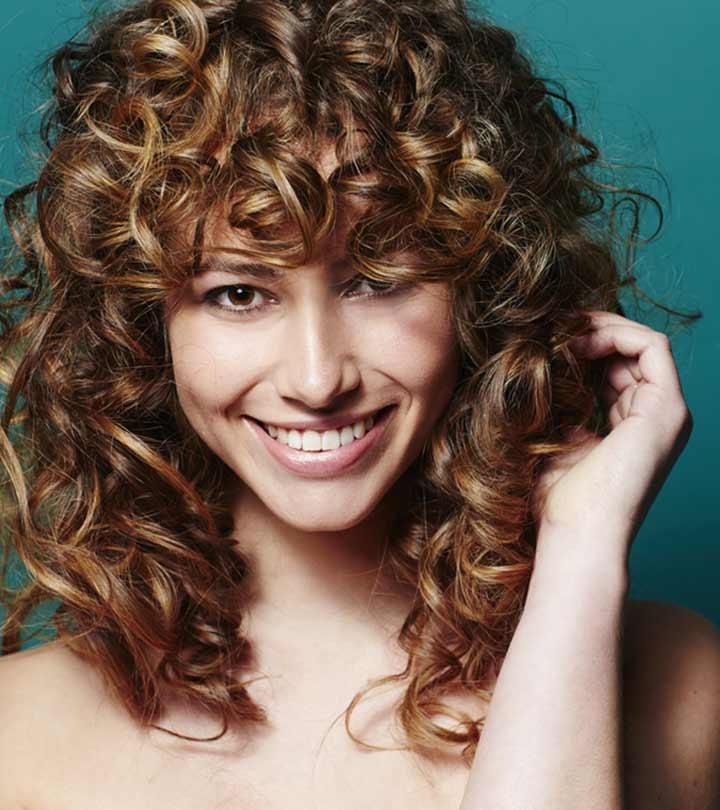Mahogany Vs. Burgundy Hair Color: Which One Is Better?
Unveil the distinct charms and differences of these two colors.

Image: Shutterstock
Red-based hair colors are currently in vogue with two prominent shades taking the spotlight – mahogany and burgundy. While these two hues may bear a striking resemblance, they are not interchangeable. The perennial debate of mahogany vs. burgundy hair colors highlights the subtle yet significant differences between the two. It sheds light on the nuances that make each shade unique. So, what sets these shades apart from each other? Are they similar in intensity and tone? Do they have different undertones? In this article, you will discover the answers to these questions and also learn about a few maintenance tips for colored hair. Continue reading.
In This Article
What Is Burgundy?
Burgundy, a color reminiscent of Burgundy wine, is a red shade with a slight brown tint and heavy purple undertones. It has various shades, such as darker tones like old burgundy and brighter ones like vivid burgundy. The purple undertones make this shade a vibrant and eye-catching choice. Burgundy is widely used in hair dye, makeup, and fashion due to its association with ambition and power. It gives off a luxurious vibe, making it a popular color for those seeking a sophisticated look.
 Trivia
TriviaAnother similar rich and sophisticated color is mahogany. Though dark like burgundy, mahogany is a different mood altogether. Check out the next section to read more about this color.
What Is Mahogany?
Mahogany, inspired by the rich reddish-brown hues of mahogany wood, is a versatile color used in both furniture and hair coloring. It comes in a variety shades, made with varying concentration blends of different red and brown colors, from cherry mahogany and cinnamon brown to burnt vienna and bright mahogany. This color adds a nice warmth and vibrancy to your hair, making it a sought-after color option for those looking to add depth and richness to their locks. It exudes elegance and sophistication and is a timeless choice for hair color enthusiasts.
 Trivia
TriviaDistinguishing between burgundy and mahogany can be challenging due to their striking similarity. You may be required to look closely to distinguish between these two.
Mahogany Vs. Burgundy Hair Colors
When exploring the differences between mahogany and burgundy hair colors, it is important to delve into various aspects, such as their shade variations, to fully understand their distinctions.
- Hue And Shade Variations
While both mahogany and burgundy fall under the red color category, they achieve their distinct hues through different color mixtures. You mix red and brown pigments to make mahogany, resulting in an earthy shade. On the other hand, burgundy incorporates richer red tones with subtle hints of brown and heavy purple or blue undertones, creating a cooler hue.
- Undertones
When it comes to mahogany and burgundy hair colors, the key lies in their undertones. Mahogany lean towards warmer earthy brown undertones. On the other hand, burgundy uses cooler purple or blue undertones to achieve its rich shade. While both colors exude elegance and charm, the subtle variation in undertones adds a unique flair to each, allowing you to choose the hue that best complements your skin tone and personal style. So if you tend to wear cooler color clothes and jewelry, burgundy may suit better. And mahogany is more suited for those who choose warmer colored clothes and jewelry.
- Intensity
While both shades are on the darker spectrum of red, burgundy is more deeper. Mahogany, though dark, has a warm glow that makes it look less intense compared to burgundy. The difference between the colors may not be very clear depending on their shade. Sometimes, a lighter burgundy shade can look more like mahogany. Still, most people see burgundy hair as darker hair overall.
- Suitability: Which Color Matches Your Skin Tone?
Determining the best hair color for you depends on your skin tone. Mahogany is a warm shade that works well with warm skin tones, while burgundy suits neutral or cool undertones. Burgundy is great for those with medium or fair skin and pink or blue undertones. On the other hand, mahogany complements warm skin tones, especially those with golden or olive undertones. The copper tones of this shade suit darker skin tones. It is important to get advice from a professional colorist to find the perfect shade for you.
- Versatility And Flexibility
Mahogany has a consistent brown base, offering greater flexibility and ease of maintenance compared to burgundy. This means you can use it to experiment with various hair coloring techniques, such as highlights, babylights, and balayage techniques, in both warm and cool tones. On the other hand, working with burgundy can be more challenging due to its red and purple undertones. You are limited to violet and copper highlights that produce stunning results but offer you restricted choices..
- Gray Coverage: Which Color Works Better In Hiding Gray Hair?
Mahogany works better in hiding your gray hair by skillfully coloring them in a beautiful deep golden shade. It can offer natural-looking highlights that seamlessly blend with your mahogany brown hair. However, burgundy hair color tends to produce a purplish-pink tone on gray hair that can clash with your natural skin tone. This makes mahogany the preferred choice for gray hair, offering a more flattering result.
- Longevity: How Long Does The Color Last?
Mahogany pigments tend to penetrate the hair shaft deeply, resulting in a longer-lasting and more consistent color while the lighter and more vibrant pigments in burgundy tend to fade more quickly. Additionally, mahogany tends to fade gradually into a subdued yet recognizable shade. Burgundy often transitions into some variant of mahogany as it fades.
Yoannita, a beauty and lifestyle blogger, colored her hair in a burgundy red shade at home. She has previously colored her hair in a medium ash blonde color. So to achieve a redder shade, she used a light burgundy blonde dye. She writes, “I’m so in love with my new hair color and thinking to get the permanent hair color on this shade (i).” She also added that red hair washes off faster than any hair color and is the hardest color to maintain.
The longevity of the colors also depends on how well you take care of your hair and the color. Here are a few maintenance tips for caring for your mahogany and burgundy hair colors.
Maintenance And Care
Maintaining the vibrancy of a mahogany or burgundy hair color involves following proper hair care practices. However, those work the same way for both colors.
- Use color-safe shampoos and conditioners that are specifically formulated for colored hair to maintain vibrancy.
- Minimize heat styling and protect your hair from UV rays to prevent color fading.
- Invest in quality hair care products, such as sulfate-free shampoos and hydrating conditioners, to nourish and protect colored hair.
- Incorporate color-protecting hair masks and serums into your routine to prolong the life of your mahogany or burgundy hair color.
- Schedule regular salon visits for touch-ups and root maintenance to keep your red hair color looking vibrant and fresh.
- Consult a colorist for personalized advice on touch-up frequency based on your hair type and desired results.
- Limit exposure to chlorinated water, as it can strip color from your hair (1). Consider wearing a swim cap or rinsing your hair with fresh water before swimming.
- Avoid over-washing your hair, as excessive washing can strip away natural oils and fade color faster (2). Wash your hair 2-3 times per week or as needed based on your hair type and activity level.
- Deep condition your hair regularly to maintain moisture and prevent dryness that may dull the color.
- Protect your hair from environmental stressors by wearing hats or scarves in harsh weather conditions.
- Be mindful of styling products containing alcohol, as they can be drying and contribute to color fading.
Even with diligent maintenance, there are potential issues associated with hair coloring that you should be aware of. Keep reading to know more.
Potential Challenges
- Color Fading: Despite using color-safe products and minimizing heat styling, both colors may fade over time. For instance, prolonged sun exposure or repeated washes can cause hair color to lose its vibrancy, resulting in a duller appearance (3). Similarly, the hair color may fade to a lighter shade of brown with repeated washes.
- Root Regrowth: As your hair grows, its natural roots will start to show, requiring touch-ups to maintain the color’s integrity. For example, with burgundy hair, the contrast between the vibrant reddish-purple tone and your natural hair color may become more noticeable over time. Similarly, mahogany hair may display a stark contrast between the deep brown hue and the emerging roots.
- Dryness And Damage: Both burgundy and mahogany hair colors may lead to dryness and damage if not properly cared for. For instance, frequent coloring sessions or overuse of heat styling tools can make your hair prone to breakage and split ends if not adequately moisturized and nourished (4).
- Color Variation: Due to individual hair characteristics, the appearance of burgundy and mahogany colors may vary from person to person. For instance, someone with naturally dark hair may achieve a deeper, more intense burgundy shade compared to someone with lighter hair. Similarly, the undertones of mahogany hair color may appear differently depending on the underlying hair color.
- Allergic Reactions: Though rare, allergic reactions can occur with both burgundy and mahogany hair color products. For example, some individuals may experience scalp irritation or redness after applying hair dye containing certain chemicals (5). It may manifest as itching or swelling of the scalp.
- Overlapping Color: With multiple coloring sessions, both burgundy and mahogany hair colors can suffer from overlapping, resulting in uneven or brassy tones. For instance, if burgundy hair dye is applied too frequently without proper spacing, the color may appear patchy or uneven. Similarly, mahogany hair color may develop unevenly if applied over previously colored sections without proper blending.
- Hair Porosity: Hair with varying levels of porosity may absorb burgundy and mahogany colors differently, leading to uneven or patchy results. For example, highly porous hair may absorb burgundy dye more readily, resulting in a darker, more intense color compared to less porous hair. Similarly, mahogany hair color may appear uneven if applied to hair with uneven porosity levels.
- Hair Texture Changes: Chemical processes involved in coloring can alter the texture of colored hair, making it more susceptible to frizz, breakage, or brittleness (6). Following a hair care regimen that incorporates deep conditioning treatments and regular haircuts is important to promote hair health and prevent hair texture change.
When considering the debate between mahogany vs. burgundy hair colors, it is clear that each offers its own unique appeal and considerations. Understanding the differences in hue, undertones, intensity, and suitability for various skin tones are important in making the perfect choice for your hair. Maintenance and proper care play a significant role in preserving the vibrancy and health of both colors, requiring diligence and attention to detail. Ultimately, whether you opt for the warmth of mahogany or the sophistication of burgundy, both colors can beautifully enhance your look and express your personal style with confidence.
Frequently Asked Questions
Can I mix mahogany and burgundy for a customized color?
Yes, you can mix mahogany and burgundy hair colors to create a customized shade. Experimenting with different ratios of the two colors allows you to achieve a unique hue that suits your preferences. However, it is advisable to conduct a strand test first to ensure the desired result before applying it to your entire hair.
Are there specific hair care products recommended for mahogany- or burgundy-colored hair?
Yes, there are specific hair care products recommended for mahogany or burgundy colored hair. Look for color-safe shampoos and conditioners formulated for colored hair to maintain vibrancy. Also, you may invest in hydrating and sulfate-free products to nourish and protect your colored locks.
Do mahogany and burgundy colors require special attention during the summer months?
Yes, mahogany and burgundy colors may require special attention during the summer months. To prevent color fading from sun exposure, it is essential to use UV protection products and limit exposure to direct sunlight. Also, consider wearing hats or scarves to shield your hair from harsh UV rays and minimize color damage.
How long does the color typically last for mahogany and burgundy hair?
The longevity of mahogany and burgundy hair color can vary depending on factors such as hair porosity, maintenance, and exposure to external elements. Therefore, the definite time cannot be determined.
Can mahogany or burgundy be combined with other colors?
Yes, mahogany or burgundy can be combined with other colors to create unique and personalized hair shades. You can experiment with coloring techniques like adding highlights, lowlights, or ombre effects using complementary tones like caramel, copper, or even blonde for added dimension and contrast. However, it is recommended to consult with a professional colorist to ensure the desired result and minimize potential color mishaps.
Do mahogany or burgundy hair colors require bleach for dark hair?
Whether mahogany or burgundy hair colors require bleach for dark hair depends on the desired outcome and the natural color of your hair. In many cases, especially for those with dark hair, bleaching is necessary to lighten the hair before applying mahogany or burgundy shades to achieve the desired vibrancy and intensity. However, for those with lighter hair colors, bleaching may not be required, or a lower volume developer may be sufficient to achieve the desired results. Consulting with a professional colorist is recommended to determine the best approach for your specific hair type and color goals.
Key Takeaways
- Burgundy and mahogany hair colors offer distinct hues and undertones, with Burgundy leaning towards cooler tones and mahogany towards warmer ones.
- The appearance of burgundy and mahogany colors may vary depending on individual hair characteristics.
- Maintenance for both colors involves using color-safe products, minimizing heat styling, and scheduling regular salon visits for touch-ups.
- Both colors can pose challenges such as color fading, root regrowth, dryness, and potential allergic reactions.
Although Mahogany and Burgundy hair colors may bear resemblance, they possess distinct undertones and hues. Wondering how to distinguish these colors? Watch this video to learn the major differences between burgundy and mahogany.
Personal Experience: Source
StyleCraze's articles are interwoven with authentic personal narratives that provide depth and resonance to our content. Below are the sources of the personal accounts referenced in this article.
(i) Hair Transformation: From Medium Ash Blonde to Burgundy Red (Demi Permanent Hair Color)
https://yoannita90.blogspot.com/2015/07/hair-transformation-from-medium-ash.html
References
Articles on StyleCraze are backed by verified information from peer-reviewed and academic research papers, reputed organizations, research institutions, and medical associations to ensure accuracy and relevance. Read our editorial policy to learn more.
- Hair color damages caused by exposure to chlorinated water in the presence of ultraviolet radiation
https://www.researchgate.net/publication/236109930_Hair_color_damages_caused_by_exposure_to_chlorinated_water_in_the_presence_of_ultraviolet_radiation - Protection of oxidative hair color fading from shampoo washing by hydrophobically modified cationic polymers
https://pubmed.ncbi.nlm.nih.gov/19450422/ - Fading of artificial hair color and its prevention by photofilters
https://pubmed.ncbi.nlm.nih.gov/16538296/ - Hair shaft damage from heat and drying time of hair dryer
https://pubmed.ncbi.nlm.nih.gov/22148012/ - Allergic contact dermatitis of the scalp associated with scalp applied products: a systematic review of topical allergens
https://pubmed.ncbi.nlm.nih.gov/35318978/ - Hair cosmetics: an overview
https://www.ncbi.nlm.nih.gov/pmc/articles/PMC4387693/
Read full bio of Anjali Sayee
Read full bio of Aparna Harry





